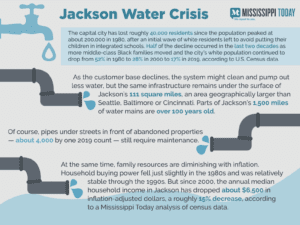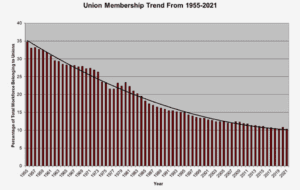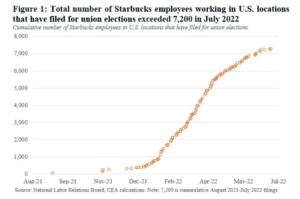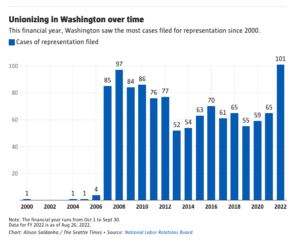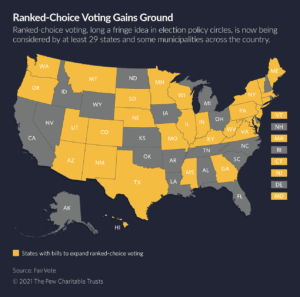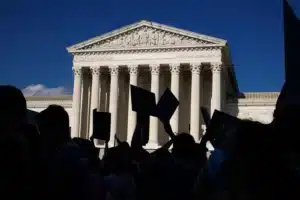 On October 31, 2022, the Supreme Court heard two cases regarding the use of race in college admissions.1 Rulings on these affirmative action cases could force many universities to reshape their admissions processes.
On October 31, 2022, the Supreme Court heard two cases regarding the use of race in college admissions.1 Rulings on these affirmative action cases could force many universities to reshape their admissions processes.
The History of Affirmative Action and the Supreme Court
The present-day context of the term “affirmative action” grew from executive orders by Presidents John F. Kennedy and Lyndon B. Johnson in the 1960s, which stated that government contractors should “take affirmative action” to ensure nondiscrimination in employment.3 After the idea expanded to education, the Supreme Court issued a landmark decision in Regents of the University of California v. Bakke (1978), a case dealing with a California medical school that had set aside 16 of 100 spots for minority applicants.4 A fractured Court ruled that schools could use race as one of several admissions criteria, but the rigid quota in this instance was impermissible.5
In 2003, the Supreme Court found that the University of Michigan’s points system was too broadly preferential to minority candidates.6 Simultaneously, the Court ruled that race could still be considered a factor in admissions if done so in the individualized manner used by the University of Michigan Law School.7 One of the named plaintiffs in the Michigan case went on to advocate for a ballot initiative banning the state’s public universities from considering race (the Court upheld the ban in 2014).8 To date, in the 10 states with policies to this effect, universities have attempted other methods of increasing minority enrollment.9 In reviewing a 2016 case out of Texas, the Court largely upheld its 2003 decisions.10
What Are the Current Legal Arguments Surrounding Affirmative Action?
The cases presently under consideration center on the University of North Carolina (UNC) and Harvard University.11 As a state institution, UNC is subject to the clause of the 14th Amendment that guarantees equal protection of the laws.12 That clause does not apply to Harvard as a private institution, but Title VI of the Civil Rights Act of 1964—which prohibits racial discrimination in any recipient of federal funding—applies to both schools.13
The legal test that the Supreme Court uses in cases that involve equal protection and race is called strict scrutiny.14 To meet the burden, the schools must show that their policies serve a compelling government interest and use a narrowly tailored means to further that interest.15 In the Bakke decision, the Court ruled that addressing historical racial injustice was not a compelling government interest given its impact on individuals not responsible for that harm.16 However, in that case and all relevant rulings that have followed, the Court has cited the creation of a diverse student body as a compelling interest.17 In the affirmative action cases presently before the Court, the justices will again decide if diversity is a compelling enough interest to allow the schools to use race as a factor in admissions.18
Even if the Supreme Court continues to uphold diversity as a compelling interest, it must still answer the other question that strict scrutiny poses: are the methods used to gain diversity narrowly tailored? Previous rulings have said that meeting that standard requires a holistic, individual review of candidates in which race is not a determining factor, that the process doesn’t cause undue harm to nonminority candidates, and that no workable alternatives would serve the school’s goal.19
What Happened at the Supreme Court Hearing This Week?
During Monday’s hearings, a majority of justices expressed skepticism about whether the current cases meet strict scrutiny.
Justice Samuel Alito seemed to suggest that there were no means schools could use that would be sufficiently narrowly tailored when he asked, “What is your response to the simple argument that college admissions are a zero-sum game?”20 Justice Amy Coney Barrett and Chief Justice John Roberts questioned the need to explicitly list race to achieve diversity. Justice Roberts asked if Harvard could consider “what an applicant would say in an essay about having to confront discrimination growing up and how he or she did that?”21 The lawyer challenging Harvard indicated that such a method would be acceptable.22
Justice Ketanji Brown Jackson suggested that UNC’s current methods are narrowly tailored since the school examines 40 different factors, thereby “looking at the full person.”23 Justice Elena Kagan expressed support for diversity as a compelling interest, saying, “I thought part of what it meant to be an American and to believe in American pluralism is that actually our institutions … are reflective of who we are as a people in all our variety.”24
LISTEN to the Supreme Court Hearing of Students for Fair Admissions v. University of North Carolina
LISTEN to the Supreme Court Hearing of Students for Fair Admissions v. President and Fellows of Harvard
What’s Next?
If the Supreme Court ends affirmative action, how it does so could be significant. A finding that affirmative action policies violate Title VI would be more limited than a ruling finding a violation of the 14th Amendment.25 The latter, as a constitutionally based ruling, could have implications on voting rights and other policy areas.26
Leading up to the hearing, both supporters and opponents of affirmative action rallied in Washington, D.C.27 The rallies included affected university students who promised to continue their advocacy beyond the Supreme Court’s hearing and ruling.28 The Court will likely issue its decision next year.29
Discussion Questions
- Is it important and valuable for universities to have a diverse student body?
- Justice Kagan called universities “pipelines to leadership in our society.”30 Do you agree with this idea? Why or why not? Does developing effective leaders require a diverse student body?
- President Joe Biden’s administration argued that it was critical for national security that service academies and universities provide the military a racially diverse officer corps, citing racial tensions and violence during the Vietnam War when the officer corps was largely white and the enlisted force was largely made up of minorities.31 In the words of White House officials, “At present, it’s not possible to achieve that diversity without race-conscious admissions.”32
- Do you agree with this idea? Why or why not?
- Is diversity in the military a compelling enough government interest to warrant affirmative action policies at universities? Why or why not?
- Is there any fair, narrowly tailored way for universities to execute an affirmative action program?
- During the hearing, Justice Alito cast doubt on whether any means used to execute affirmative action programs can be narrowly tailored, saying, “Two people are in a race, and you give a plus factor to one of the runners, so that runner gets to start … five yards closer to the finish line. The one who doesn’t get that plus factor is disadvantaged, right?”33
- Do you agree with this reasoning? Why or why not?
- Do you think this analogy fits well with college admissions? Why or why not?
- During the hearing, some justices asked about other programs to address diversity, such as offering significant financial aid or dedicated outreach to low-income students and those who would be the first generation of their family to attend college.34 University lawyers argued that they have tried these methods with less success than the race-conscious policies currently in use.35
- Is socioeconomic status a good metric to use to achieve diversity? Why or why not?
- Do you think these or other race-neutral methods can ensure an effectively diverse student body?
- In order to effectively ensure diversity, do you think colleges must explicitly consider race? Why or why not?
- Consider the following two quotes from Supreme Court justices:
- “The way to stop discrimination on the basis of race, is to stop discriminating on the basis of race.” —Chief Justice Roberts, 200736
- “The way to stop discrimination on the basis of race is to speak openly and candidly on the subject of race, and to apply the Constitution with eyes open to the unfortunate effects of centuries of racial discrimination.” —Justice Sonia Sotomayor, 201437
- Which of these quotes do you think is most relevant to the issue of affirmative action?
- Which justice do you agree with more? Why?
As always, we encourage you to join the discussion with your comments or questions below.
Sources
Featured Image Credit: Andrew Lichtenstein/Corbis via Getty Images
[1] NBC News: https://www.nbcnews.com/politics/supreme-court/supreme-court-hears-challenges-affirmative-action-college-admissions-rcna54564
[2] Politico: https://www.politico.com/news/2022/10/28/supreme-court-affirmative-action-end-00063931
[3] Smithsonian Magazine: https://www.smithsonianmag.com/history/learn-origins-term-affirmative-action-180959531/
[4] Ibid.
[5] Oyez: https://www.oyez.org/cases/1979/76-811
[6]. Ballotpedia: https://ballotpedia.org/Gratz_v._Bollinger; Oyez: https://www.oyez.org/cases/2002/02-516
[7] Justia: https://supreme.justia.com/cases/federal/us/539/306/; Oyez: https://www.oyez.org/cases/2002/02-241
[8] Center for Individual Rights: https://www.cir-usa.org/case/gratz-v-bollinger-grutter-v-bollinger/gratz-grutter-frequently-asked-questions/; NPR: https://www.npr.org/sections/thetwo-way/2014/04/22/305850221/supreme-court-affirms-ban-on-race-conscious-college-admissions; Time: https://time.com/71871/supreme-court-affirmative-action-michigan/
[9] Associated Press: https://apnews.com/article/bbe0f81d2b4ef63102d749879c045a10; Associated Press: https://apnews.com/article/voting-rights-ketanji-brown-jackson-us-supreme-court-college-admissions-affirmative-action-196ab930c799bcdc8b2a4a220641dd48; Atlanta Journal-Constitution: https://www.ajc.com/news/local-education/court-ruling-changed-georgia-approach-race-based-college-admissions/vT9wYxSGa0kCv7EqkdczdK/; Century Foundation: https://tcf.org/content/commentary/what-can-we-learn-from-states-that-ban-affirmative-action/?agreed=1; James G. Martin Center for Academic Renewal: https://www.jamesgmartin.center/2019/10/did-you-know-eight-states-ban-racial-preferences-in-college-admissions/; Politico: https://www.politico.com/news/magazine/2022/10/31/supreme-court-affirmative-action-ban-00064058
[10] Oyez: https://www.oyez.org/cases/2015/14-981; Texas Tribune: https://www.texastribune.org/2016/06/23/us-supreme-court-rules-fisher-case-involving-ut-au/
[11] CNN: https://edition.cnn.com/2022/08/03/politics/affirmative-action-supreme-court-harvard-north-carolina/index.html
[12] CNN: https://edition.cnn.com/2022/08/03/politics/affirmative-action-supreme-court-harvard-north-carolina/index.html; Oyez: https://www.oyez.org/cases/2022/21-707
[13] Bloomberg Law: https://news.bloomberglaw.com/us-law-week/elite-college-admissions-cases-put-justices-on-collision-course
[14] Cornell Law School Legal Information Institute: https://www.law.cornell.edu/wex/strict_scrutiny
[15] Ibid.
[16] CNN: https://edition.cnn.com/2022/10/27/politics/affirmative-action-supreme-court-1978-bakke-harvard-north-carolina/index.html; Vox: https://www.vox.com/policy-and-politics/23405267/affirmative-action-supreme-court-race-harvard-unc-chapel-hill
[17] Ibid.
[18] Oyez: https://www.oyez.org/cases/2022/20-1199; Oyez: https://www.oyez.org/cases/2022/21-707
[19] Oyez: https://www.oyez.org/cases/2002/02-241; Oyez: https://www.oyez.org/cases/2015/14-981
[20] Georgia Public Broadcasting: https://www.gpb.org/news/2022/10/31/supreme-courts-conservatives-appear-skeptical-of-affirmative-action-in-admissions
[21] NBC News: https://www.nbcnews.com/politics/supreme-court/supreme-court-hears-challenges-affirmative-action-college-admissions-rcna54564
[22] Ibid.
[23] Associated Press: https://apnews.com/article/voting-rights-ketanji-brown-jackson-us-supreme-court-college-admissions-affirmative-action-196ab930c799bcdc8b2a4a220641dd48
[24] Ibid.
[25] Bloomberg Law: https://news.bloomberglaw.com/us-law-week/elite-college-admissions-cases-put-justices-on-collision-course
[26] Ibid.
[27] Georgia Recorder: https://georgiarecorder.com/2022/10/31/affirmative-action-supporters-rally-outside-the-u-s-supreme-court/; Harvard Crimson: https://www.thecrimson.com/article/2022/10/31/duel-rallies-admissions-dc-scotus/
[28] Harvard Crimson: https://www.thecrimson.com/article/2022/10/31/duel-rallies-admissions-dc-scotus/
[29] SCOTUSblog: https://www.scotusblog.com/2022/10/affirmative-action-appears-in-jeopardy-after-marathon-arguments/
[30] Associated Press: https://apnews.com/article/voting-rights-ketanji-brown-jackson-us-supreme-court-college-admissions-affirmative-action-196ab930c799bcdc8b2a4a220641dd48
[31] Georgia Public Broadcasting: https://www.gpb.org/news/2022/10/31/supreme-courts-conservatives-appear-skeptical-of-affirmative-action-in-admissions; SCOTUSblog: https://www.scotusblog.com/2022/10/affirmative-action-appears-in-jeopardy-after-marathon-arguments/
[32] Georgia Public Broadcasting: https://www.gpb.org/news/2022/10/31/supreme-courts-conservatives-appear-skeptical-of-affirmative-action-in-admissions
[33] Ibid.
[34] SCOTUSblog: https://www.scotusblog.com/2022/10/affirmative-action-appears-in-jeopardy-after-marathon-arguments/
[35] Ibid.
[36] Smithsonian Magazine: https://www.smithsonianmag.com/history/learn-origins-term-affirmative-action-180959531/
[37] Politico: https://www.politico.com/news/2022/10/28/supreme-court-affirmative-action-end-00063931
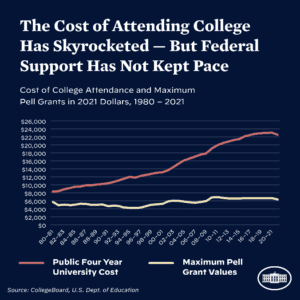
 Last Wednesday, the Food and Drug Administration expanded eligibility for updated COVID-19 booster shots to include children as young as five. Prior to this announcement, the revised Pfizer vaccine was restricted to those 12 and older and the Moderna vaccine was restricted to those 18 and older.1
Last Wednesday, the Food and Drug Administration expanded eligibility for updated COVID-19 booster shots to include children as young as five. Prior to this announcement, the revised Pfizer vaccine was restricted to those 12 and older and the Moderna vaccine was restricted to those 18 and older.1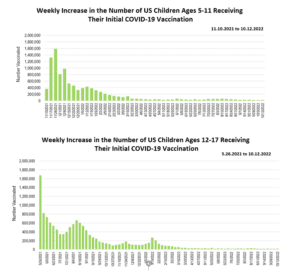
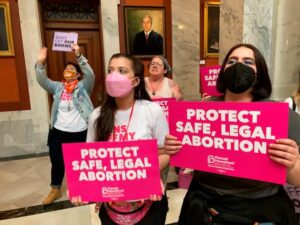 On October 6, three Jewish women filed a lawsuit against the state of Kentucky claiming that the state’s current abortion restrictions are vague and violate their religious freedom.1 Kentucky’s state legislature passed a series of bills in 2019 that banned abortion from fertilization, only allowing for abortion if the mother’s life is in danger. There are no exceptions for rape or incest.2
On October 6, three Jewish women filed a lawsuit against the state of Kentucky claiming that the state’s current abortion restrictions are vague and violate their religious freedom.1 Kentucky’s state legislature passed a series of bills in 2019 that banned abortion from fertilization, only allowing for abortion if the mother’s life is in danger. There are no exceptions for rape or incest.2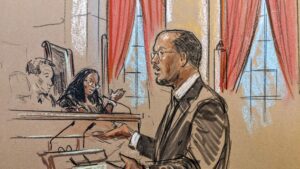 On October 4, the Supreme Court heard oral argument in the case of Merrill v. Milligan. In that case, the Court is considering whether the Voting Rights Act of 1965 should apply to Alabama’s recent congressional redistricting. One section of the Voting Rights Act requires that states provide minority voters with “an equal opportunity to participate in the political process.”1
On October 4, the Supreme Court heard oral argument in the case of Merrill v. Milligan. In that case, the Court is considering whether the Voting Rights Act of 1965 should apply to Alabama’s recent congressional redistricting. One section of the Voting Rights Act requires that states provide minority voters with “an equal opportunity to participate in the political process.”1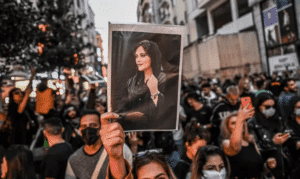 In recent days, Iran has been gripped by a series of mass protests that have gained international attention. The protests, largely led by women, are somewhat unprecedented. While both protest and women’s participation in protests in Iran are not new, the protests of the past two weeks are remarkable as the first of such scale specifically directed by Iranian women and centered on women’s civil rights in the country.1
In recent days, Iran has been gripped by a series of mass protests that have gained international attention. The protests, largely led by women, are somewhat unprecedented. While both protest and women’s participation in protests in Iran are not new, the protests of the past two weeks are remarkable as the first of such scale specifically directed by Iranian women and centered on women’s civil rights in the country.1 On August 29, 2022, Mississippi Governor Tate Reeves declared a state of emergency for Jackson, the state capital, which was in the midst of an ongoing water crisis.1 Heavy rainfall caused the Pearl River and Ross Barnett Reservoir to flood, which in turn overwhelmed two water treatment plants that were already strained.2 Low water pressure and contamination left the city of 150,000 people—the largest in the state—without safe, reliable running water.3
On August 29, 2022, Mississippi Governor Tate Reeves declared a state of emergency for Jackson, the state capital, which was in the midst of an ongoing water crisis.1 Heavy rainfall caused the Pearl River and Ross Barnett Reservoir to flood, which in turn overwhelmed two water treatment plants that were already strained.2 Low water pressure and contamination left the city of 150,000 people—the largest in the state—without safe, reliable running water.3